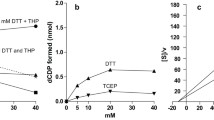Abstract
Model reactions were devised to investigate the capacity of physiologically interesting thiol compounds to mediate reactions between CrO4 2− (Cr (VI)) and DNA. The sulfhydryl containing reagents included cysteine, glutathione, apo‐metallothionein (apoMT). Zinc finger 3 of transcription factor IIIA (Zn‐F3) of Xenopus laevis was investigated as a potential redox active site of reaction of Cr (VI) and thiol compounds. The DNA samples were calf thymus DNA and two oligomers, one of them specific for binding Zn-F3. Results showed that in the presence of Cr (VI) apoMT readily participated in damaging DNA in a reaction that appeared to be hydroxyl radical dependent. It also became cross‐linked to oligomer and native DNA samples. In comparison, the other two thiol donors were largely inactive in these assays even though they, like apoMT, were able to reduce Cr (VI) to Cr (III) under the conditions of the experiments. Direct attempts to cross link thiols with DNA in the presence of Cr3+ were unsuccessful at pH 7.4. Together, the results indicate that apoMT can effectively collaborate with Cr (VI) in reactions that are deleterious to DNA.
Similar content being viewed by others
References
O'Brien P, Kortenkamp A: Chemical models important in understanding the ways in which chromate can damage DNA. Environ Health Perspect 102: 3–10, 1994
Levina A, Barr-David G, Codd R, Lay PA, Dixon NE, Hammershoi A, Hendry P: In vitro plasmid DNA cleavage by chromium (V) and (IV) 2-hydroxycarboxylato complexes. Chem Res Toxicol 12: 371–381, 1999
Shi X, Ding M, Ye J, Wang S, Leonard SS, Zang L, Castranova V, Vallyathan V, Chiu A, Dalal N, Liu KJ: Cr (IV) causes activation of nuclear transcription factor-kappa B, DNA strand breaks and dG hydroxylation via free radical reactions. Inorg Biochem 75: 37–44, 1999
Myers CR, Myers JM: Iron stimulates the rate of reduction of hexavalent chromium by human microsomes. Carcinogenesis 19: 1029–1038, 1998
Stearns DM, Courtney KD, Giangrande PH, Phieffer LS, Wetterhahn KE: Chromium (VI) reduction by ascorbate: Role of reactive intermediates in DNA damage in vitro. Environ Health Perspect 102: 21–25, 1994
Wiegand HJ, Ottenwalder H, Bolt HM: The reduction of chromium (VI) to chromium (III) by glutathione: an intracellular redox pathway in the metabolism of the carcinogen chromate. Toxicology 33: 341–348, 1984
Sugden KD, Wetterhahn KE: Direct and hydrogen peroxide-induced chromium (V) oxidation of deoxyribose in single-stranded and doublestranded calf thymus DNA. Chem Res Toxicol 10: 1397–1406, 1997
Casadevall M, da Cruz Fresco P, Kortenkamp A: Chromium (VI)-mediated DNA damage: Oxidative pathways resulting in the formation of DNA breaks and abasic sites. Chem Biol Interact 123: 117–132, 1999
Liu S, Medvedovic M, Dixon K: Environ Mutational specificity in a shuttle vector replicating in chromium (VI)-treated mammalian cells. Mol Mutagen 33: 313–319, 1999
Luo H, Lu Y, Mao Y, Shi X, Dalal NS: Role of chromium (IV) in the chromium (VI)-related free radical formation, dG hydroxylation, and DNA damage. J Inorg Biochem 64: 25–35, 1996
Petering D, Fowler B: Roles of metallothionein and related proteins in metal metabolism and toxicity: Problems and perspectives. Environ Health Perspect 65: 217–224, 1986
Krepkiy D, Petering DH: unpublished information
Pattanaik A, Shaw CF III, Petering DH, Garvey J, Kraker AJ: Basal metallothionein in tumors: Widespread presence of apoprotein. J Inorg Biochem 54: 91–105, 1994
Sarkar B: Metal replacement in DNA-binding zinc finger proteins and its relevance to mutagenicity and carcinogenicity through free radical generation. Nutrition 11: 646–649, 1995
Muñoz A, Laib F, Petering DH, Shaw CF III: Characterization of the cadmium complex of peptide 49-61: A putative nucleation center for cadmium-induced folding in rabbit liver metallothionein IIA. J Biol Inorg Chem 4: 495–507, 1999
Sambrook J, Fritsch EF, Maniatis T: In: Molecular Cloning (A Laboratory Manual), 2nd edn. Cold Spring Harbor Laboratory Press, 1989
Zhitkovich A, Voitkun V, Costa M: Glutathione and free amino acids form stable complexes with DNA following exposure of intact mammalian cells to chromate. Carcinogenesis 16: 907–913, 1985
Mao Q, Fulmer P, Li W, DeRose EF, Petering DH: Different conformations and site selectivity of HO2-Co (III)-bleomycin A2 and Co (III)-bleomycin A2 bound to DNA oligomers. J Biol Chem 271: 6185–6191, 1996
Zang WQ, Veldhoen N, Romaniuk PJ: Effects of zinc finger mutations on the nucleic acid binding activities of Xenopus transcription factor IIIA. Biochemistry 34: 15545–15552, 1995
Voitkun V, Zhitkovich A, Costa M: Cr (III)-mediated crosslinks of glutathione or amino acids to the DNA phosphate backbone are mutagenic in human cells. Nucleic Acids Res 26: 2024–2030, 1998
Author information
Authors and Affiliations
Corresponding author
Rights and permissions
About this article
Cite this article
Krepkiy, D., Antholine, W.E., Myers, C. et al. Model reactions of Cr (VI) with DNA mediated by thiol species. Mol Cell Biochem 222, 213–219 (2001). https://doi.org/10.1023/A:1017982717778
Issue Date:
DOI: https://doi.org/10.1023/A:1017982717778




